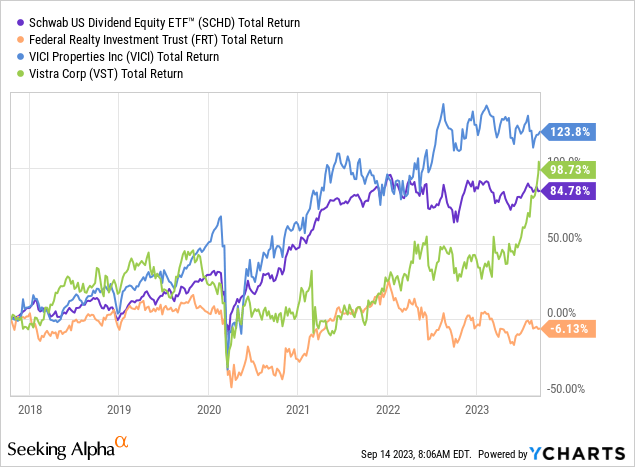Investors know that companies that consistently increase payouts tend to outperform those that don’t. A dividend increase indicates a strong business performance and a commitment to rewarding shareholders. As a watcher of such companies, I’m happy to share valuable insights on upcoming dividend increases. With my compiled helpful lists, you can confidently expect a glimpse of the stocks expected to raise their dividends in the upcoming week.
This list is a trimmed-down version, only covering dividend increases. A full upcoming dividend calendar is always available here.
How I Created The Lists
The following information results from combining the “U.S. Dividend Champions” spreadsheet on this website with upcoming dividend data from NASDAQ. This process involves merging data on companies with a history of dividend growth with their future dividend payments. It is important to note that all companies included in this list have at least five years of consistent dividend growth.
Companies are required to have higher total dividends paid out each year. Therefore, a company may not raise its dividend each calendar year, but the total annual dividend can still increase.
What Is The Ex-Dividend Date?
The ex-dividend date marks the eligibility cut-off point for the upcoming dividend or distribution. To qualify, you must have purchased shares by the close of the preceding business day. For example, if the ex-dividend date falls on a Tuesday, you must have bought (or already owned) the shares by the market close on Monday. Note that if the ex-dividend date is on a Monday (or a Tuesday if Monday is a holiday), you must have acquired the shares by the prior Friday.
Dividend Streak Categories
Here are the definitions of the streak categories, as I’ll use them throughout the piece.
- King: 50+ years.
- Champion/Aristocrat: 25+ years.
- Contender: 10-24 years.
- Challenger: 5+ years.
| Category | Count |
| King | 1 |
| Champion | 0 |
| Contender | 0 |
| Challenger | 2 |
The Dividend Increasers List
Data has been sorted by the ex-dividend day (ascending) and then by the streak (descending):
| Name | Ticker | Streak | Forward Yield | Ex-Div Date | Increase Percent | Streak Category |
| Vistra Corp. | (VST) | 5 | 2.47 | 19-Sep-23 | 0.98% | Challenger |
| VICI Properties Inc. | (VICI) | 6 | 5.31 | 20-Sep-23 | 6.41% | Challenger |
| Federal Realty Investment Trust | (FRT) | 56 | 4.47 | 21-Sep-23 | 0.93% | King |
Field Definitions
Streak: Years of dividend growth history are sourced from the U.S. Dividend Champions spreadsheet.
Forward Yield: The new payout rate is divided by the current share price.
Ex-Dividend Date: This is the date you need to own the stock.
Increase Percent: The percent increase.
Streak Category: This is the overall dividend history classification of the company.
Show Me The Money
Here’s a table mapping the new rates versus the old rates. It also reiterates the percentage increase. This table is sorted similarly to the first (ex-dividend day ascending, dividend streak descending).
| Ticker | Old Rate | New Rate | Increase Percent |
| VST | 0.204 | 0.206 | 0.98% |
| VICI | 0.39 | 0.415 | 6.41% |
| FRT | 1.08 | 1.09 | 0.93% |
Additional Metrics
Some different metrics related to these companies include yearly pricing action and the P/E ratio. The table is sorted the same way as the table above. A value investor may find stock ideas with those companies near their 52-week lows, as they could provide more margin of safety and inflated yield.
| Ticker | Current Price | 52 Week Low | 52 Week High | PE Ratio | % Off Low | % Off High |
| VST | 33.17 | 20.43 | 34.28 | 10.34 | 62% Off Low | 3% Off High |
| VICI | 31.28 | 27.79 | 34.21 | 18.78 | 13% Off Low | 9% Off High |
| FRT | 97.51 | 83.65 | 112.56 | 38.81 | 17% Off Low | 13% Off High |
Tickers By Yield And Growth Rates
I’ve arranged the table in descending order for investors to prioritize the current yield. As a bonus, the table also features some historical dividend growth rates. Moreover, I have incorporated the “Chowder Rule,” which is the sum of the current yield and the five-year dividend growth rate.
| Ticker | Yield | 1 Yr DG | 3 Yr DG | 5 Yr DG | 10 Yr DG | Chowder Rule |
| VICI | 5.31 | 8.3 | 9.5 | 29.9 | 35.2 | |
| FRT | 4.47 | 0.9 | 1 | 1.6 | 4 | 6 |
| VST | 2.47 | 20.3 | 14.4 |
Historical Returns
As an investor, I focus on identifying stocks with consistent dividend growth and a track record of outperforming the market. I use the Schwab U.S. Dividend Equity ETF (SCHD) as a benchmark to gauge their performance. This ETF has a remarkable history of exceptional performance, a higher yield than the S&P 500, and a proven record of growing dividends. If you can’t beat the benchmark, you should take it instead. I use this analysis myself and have added companies to my portfolio.
Here’s the total return chart of SCHD versus the three on the list. I normally like to compare 10-year dividend growth rates, but with only three companies this week, I’m including all. Here are some conclusions with the caveat that data only goes back to late 2017. FRT has finished down over the past six years! VICI and VST both bested SCHD in the time frame, though VST has only accelerated in the past few months, otherwise, it lagged during most of the time period.

Please do your due diligence before investing, and thanks for reading.
Read the full article here









Leave a Reply